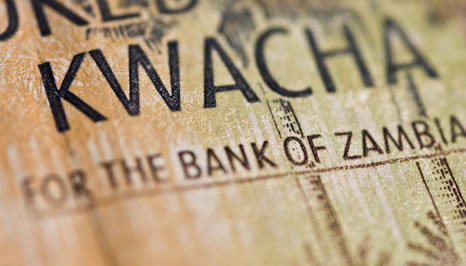Zambia's central bank raised its policy rate for the second time this year to counter rising inflationary pressures and warned it may "further adjust the policy rate upward, if inflation persistently remains above the target range."
The Bank of Zambia (BOZ) raised its policy rate by 125 basis points to 11.50 percent and has now raised it 175 points this year following an earlier hike in May.
Today's rate hike follows BOZ's warning in August that it could raise the rate if inflation didn't revert to its target range.
Since then, Zambia's inflation has continued to accelerate, rising to 10.7 percent in October, the highest rate since October 2016, from 10.5 percent in September as food prices have continued to rise following drought and the kwacha depreciates further.
The kwacha has fallen sharply since mid-October and was trading at 14.05 to the U.S. dollar today, down almost 15 percent this year.
In August BOZ expected inflation to remain above the upper bound of its target range for much of the forecast horizon but today it revised this forecast higher, saying inflation is now expected to remain above the upper bound of its 6-8 percent target range over the entire forecast horizon.
"The decision to raise the policy rate is therefore intended to counter inflationary pressures that include exchange rate pass-through effects and bring inflation back to the target range in the medium-term and hence support macroeconomic stability," BOZ said.
Looking ahead, BOZ said policy decisions would continue to be guided by inflation forecasts and outcomes, and progress in the execution of fiscal consolidation measures, BOZ said, adding monetary policy can't solve the economic challenges alone and fiscal authorities and policy makers have to implement tight spending controls and improve the collection of revenue to tackle high fiscal deficits, debt and debt service while dismantling domestic arrears.
Zambia's economy is seen slowing further in the third quarter of this year as mining output, electricity generation, cement production and output of some manufactured products has declined, BOZ said, forecasting gross domestic product growth this year falling to 2.0 percent from 4.0 percent in 2018.
In July the International Monetary Fund also forecast 2.0 percent growth this year on lower mining output and the impact of drought on hydro power generation.
In a statement today following a visit by IMF staff from Nov. 13 to Nov. 19, IMF said projected growth was now seen slowing to below 2 percent due to the impact of severe drought, which has raised risk of food insecurity.
The IMF stressed the need for a large, front-loaded and sustained fiscal adjustment in the 2020 budget being debated in parliament that would help set debt on a downward path and reduce domestic arrears while spending should be prioritized to meet key development priorities and support vulnerable populations.






































